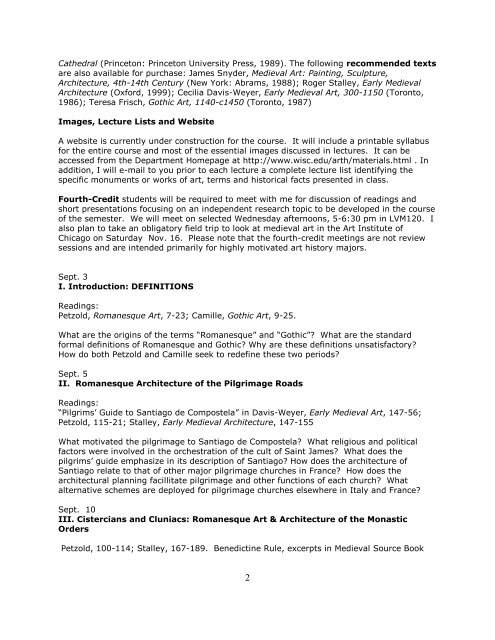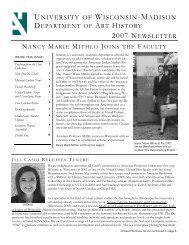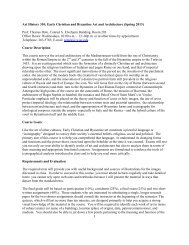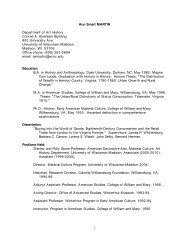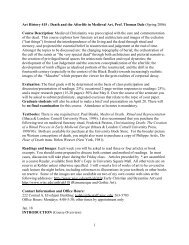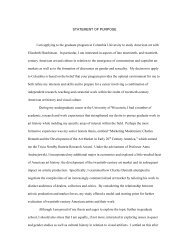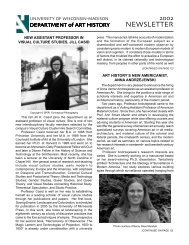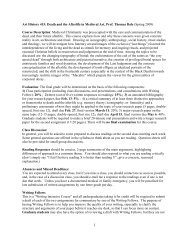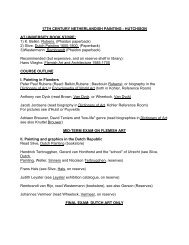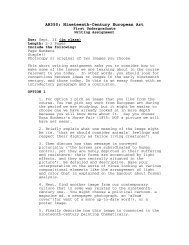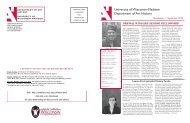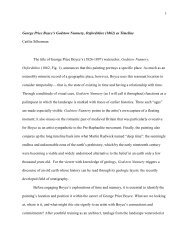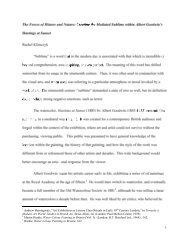Romanesque & Gothic Art & Architecture (Fall 2005) Prof. T. Dale ...
Romanesque & Gothic Art & Architecture (Fall 2005) Prof. T. Dale ...
Romanesque & Gothic Art & Architecture (Fall 2005) Prof. T. Dale ...
You also want an ePaper? Increase the reach of your titles
YUMPU automatically turns print PDFs into web optimized ePapers that Google loves.
Cathedral (Princeton: Princeton University Press, 1989). The following recommended texts<br />
are also available for purchase: James Snyder, Medieval <strong>Art</strong>: Painting, Sculpture,<br />
<strong>Architecture</strong>, 4th-14th Century (New York: Abrams, 1988); Roger Stalley, Early Medieval<br />
<strong>Architecture</strong> (Oxford, 1999); Cecilia Davis-Weyer, Early Medieval <strong>Art</strong>, 300-1150 (Toronto,<br />
1986); Teresa Frisch, <strong>Gothic</strong> <strong>Art</strong>, 1140-c1450 (Toronto, 1987)<br />
Images, Lecture Lists and Website<br />
A website is currently under construction for the course. It will include a printable syllabus<br />
for the entire course and most of the essential images discussed in lectures. It can be<br />
accessed from the Department Homepage at http://www.wisc.edu/arth/materials.html . In<br />
addition, I will e-mail to you prior to each lecture a complete lecture list identifying the<br />
specific monuments or works of art, terms and historical facts presented in class.<br />
Fourth-Credit students will be required to meet with me for discussion of readings and<br />
short presentations focusing on an independent research topic to be developed in the course<br />
of the semester. We will meet on selected Wednesday afternoons, 5-6:30 pm in LVM120. I<br />
also plan to take an obligatory field trip to look at medieval art in the <strong>Art</strong> Institute of<br />
Chicago on Saturday Nov. 16. Please note that the fourth-credit meetings are not review<br />
sessions and are intended primarily for highly motivated art history majors.<br />
Sept. 3<br />
I. Introduction: DEFINITIONS<br />
Readings:<br />
Petzold, <strong>Romanesque</strong> <strong>Art</strong>, 7-23; Camille, <strong>Gothic</strong> <strong>Art</strong>, 9-25.<br />
What are the origins of the terms “<strong>Romanesque</strong>” and “<strong>Gothic</strong>”? What are the standard<br />
formal definitions of <strong>Romanesque</strong> and <strong>Gothic</strong>? Why are these definitions unsatisfactory?<br />
How do both Petzold and Camille seek to redefine these two periods?<br />
Sept. 5<br />
II. <strong>Romanesque</strong> <strong>Architecture</strong> of the Pilgrimage Roads<br />
Readings:<br />
“Pilgrims’ Guide to Santiago de Compostela” in Davis-Weyer, Early Medieval <strong>Art</strong>, 147-56;<br />
Petzold, 115-21; Stalley, Early Medieval <strong>Architecture</strong>, 147-155<br />
What motivated the pilgrimage to Santiago de Compostela? What religious and political<br />
factors were involved in the orchestration of the cult of Saint James? What does the<br />
pilgrims’ guide emphasize in its description of Santiago? How does the architecture of<br />
Santiago relate to that of other major pilgrimage churches in France? How does the<br />
architectural planning facillitate pilgrimage and other functions of each church? What<br />
alternative schemes are deployed for pilgrimage churches elsewhere in Italy and France?<br />
Sept. 10<br />
III. Cistercians and Cluniacs: <strong>Romanesque</strong> <strong>Art</strong> & <strong>Architecture</strong> of the Monastic<br />
Orders<br />
Petzold, 100-114; Stalley, 167-189. Benedictine Rule, excerpts in Medieval Source Book<br />
2


